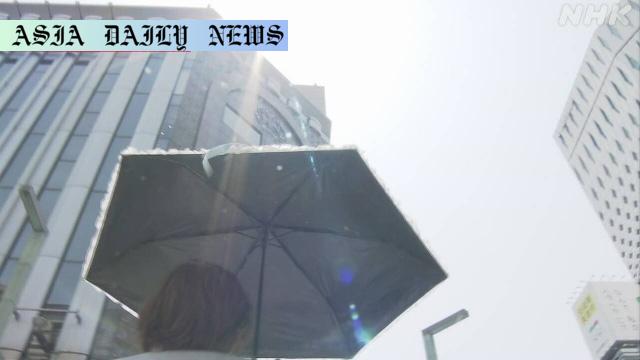Heatwave causing temperatures to soar in Japan; coastlines, cities brace for unseasonably warm weather with risks of heatstroke.

Unseasonably High Temperatures Grip Japan
Japan is currently experiencing a heatwave that has seen temperatures soar to unprecedented levels for this time of year, unsettling residents and prompting safety warnings. Over the past two days, temperatures in multiple regions have risen above 30°C, with cities such as Toyama, Tottori, and Matsumoto bearing the brunt of the heat. The nation’s Meteorological Agency attributes the unseasonably high temperatures to a combination of warm southern air circumventing a high-pressure system and a stationary front lingering over northeastern Japan. This weather anomaly has transformed what should have been mild spring months into summer-like days, challenging infrastructure, health systems, and everyday life.
Forecasted Peaks and Affected Regions
The heatwave is not showing signs of immediate relief as meteorological experts predict temperatures to climb even further. By Wednesday afternoon, Matsumoto City is expected to hit 35°C, a staggering figure indicating the severity of the conditions. Similarly, cities like Fukushima, Toyama, and Toyooka in Hyogo Prefecture are forecasted to reach around 34°C, while Tottori City will likely see 33°C. Even the capital, Tokyo, is not exempt, with central districts anticipating highs of 30°C. Coastal areas along the Sea of Japan and the inland regions appear to be the most affected, creating a geographic spectrum of concern. These rising temperatures highlight the severity of global climate changes, as they affect not just local populations but also agriculture, tourism, and urban planning strategies.
Health Precautions Amid the Heatwave
The extreme heat has prompted Japan’s authorities to issue the nation’s first heatstroke alert of the season for the Yaeyama region of Okinawa Prefecture. Such alerts are critical, as heatstroke incidents can result from prolonged exposure to excessively high temperatures without adequate hydration and safeguarding. Officials are urging residents and tourists alike to use air conditioning, drink sufficient water, and consume appropriate amounts of salt to maintain electrolyte balance. The simultaneous observance of basic protective measures such as seeking shade, wearing light and breathable clothing, and avoiding strenuous outdoor activities during peak sun hours is also emphasized. These preventive measures aim to preempt significant medical emergencies that could overwhelm local health care systems.
Rainfall Concerns Highlight Weather Extremities
While the heatwave dominates much of Japan’s climate narrative, the southwestern parts of the nation face a different weather-related problem: heavy seasonal rainfall. Kagoshima Prefecture is experiencing downpours associated with a seasonal rain front. This has significantly increased the risk of landslides in the region, threatening communities with potential natural disasters. Emergency teams stand on alert for contingencies involving both excessive heat and unpredictable rainfall. The dual nature of these weather patterns underscores the importance of adaptive strategies in combating the effects of climate extremes. Inhabitants residing in vulnerable areas and travelers navigating through these regions should stay informed through local advisories and meteorological updates.
Broader Implications of Japan’s Weather Patterns
The sudden spike in temperatures and a simultaneous increase in regional rainfall bring larger discussions about climate change to the forefront. The intersection of heatwaves and rainfall incidents represents a microcosm of global trends where weather unpredictability is becoming the norm. Governments, researchers, and communities are being increasingly pushed to prioritize climate resilience by developing efficient infrastructure, better forecasting methods, and public awareness campaigns. Japan’s ongoing challenges highlight a pressing need to embrace sustainable solutions while also attending to immediate safety and preparedness needs. This serves as a wake-up call, not just for Japan but for the world, to address the intricacies and long-term impacts of climate irregularities.
Commentary
Reflections on Japan’s Scorching Heatwave
The recent heatwave experienced in Japan is undoubtedly a stark reminder of the intensifying effects of climate anomalies around the globe. Temperatures above 30°C in spring are not just a weather event—they are an indicator of broader, systemic changes in our planet’s climate systems. As someone observing these unfolding developments, it’s alarming to see how such extremes take a toll on human health, infrastructure, and overall societal functioning. The issuing of heatstroke alerts this early in the year is unprecedented and paints a concerning picture of what the summer might hold, not just for Japan, but for other countries too.
The Immediate Impact on Daily Life
The practical implications of this heatwave cannot be ignored. From power grids being tested due to increased air-conditioning use to agricultural sectors grappling with unexpected heat stress, the ripple effects of weather extremes infiltrate every aspect of our daily lives. For residents in regions like Toyama or Okinawa, adapting to such high temperatures requires a multifaceted approach. It’s also worth appreciating the proactive stance taken by authorities, who are rolling out advisories and advocating for safety measures. Yet the reality remains that individuals who lack access to cooling devices or safe environments may remain vulnerable.
Global Lessons on Climate Preparedness
Japan’s current struggles with this heatwave provide a cautionary tale for the global community. Climate change is not an abstract concept—it is unfolding in real-time, manifesting in longer heatwaves, erratic rainfall, and heightened natural disaster risks. Countries worldwide need to take stronger collaborative action by setting greenhouse gas reduction targets, deploying sustainable energy solutions, and bolstering individuals’ capacity to withstand harsh climate impacts. For many of us observing or reporting from afar, the situation in Japan reinforces the need to advocate more fervently for environmental change and preparedness measures. Inaction is no longer an option.


